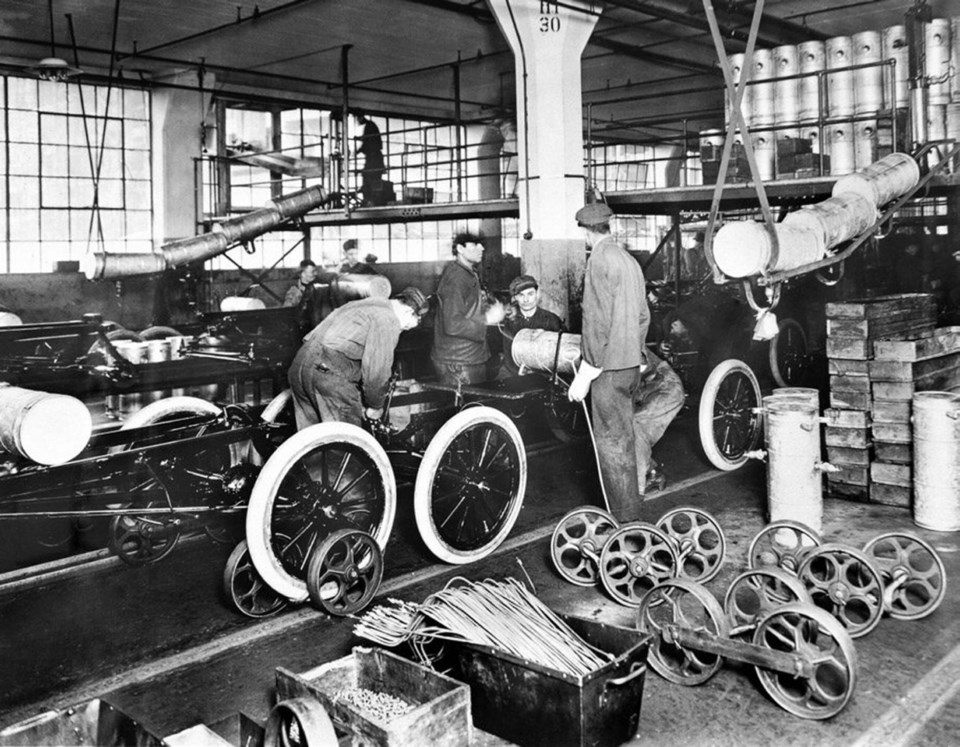While there is now much automation involved, the basic method of building cars hasn’t changed significantly over the past 100 years: move the frame or platform slowly along adding components as it passes each work station. Toyota’s lean production refined and improved it, but the process is the same.
At the end of the line, a completed vehicle is driven away. It is one of the miracles of the industrial age.
Henry Ford (the first) is often credited with the invention of the auto assembly line, but according to a close associate of Ford’s, this was not quite the case. Manufacturing chief “Cast-Iron Charlie” Sorensen, expert patternmaker and Ford Motor Co. employee from 1905 to 1944, claimed it was his idea.
According to Sorensen, Ford was an interested onlooker who didn’t discourage Sorensen and his young assistant foreman, Charles Lewis, from experimenting with the idea.
The assembly-line idea coincided with a rising interest in what was called “scientific management” espoused by several proponents, including time-and-motion guru Frederick Taylor in his 1911 book The Principles of Scientific Management.
It promised higher production efficiency by breaking jobs into small work units requiring little training. Sorensen, however, denied that Taylor had any direct influence on the Ford conversion.
In his book My Forty Years With Ford, Sorensen wrote: “It was then, when he and Lewis were experimenting with a simple form of what is now called just-in-time inventory control, that the idea occurred to me that assembly would be easier, simpler and faster if we moved the chassis along, beginning at one end of the plant with a frame and adding axles and the wheels; in effect moving it past the stockroom instead of moving the stockroom to the chassis.”
To test the idea, in 1908 Sorensen and his assistant worked every Sunday for a month in a secret room distributing car components in a line on the floor, starting with the frame, wheels, etc.
On test day, they mounted the frame on skids. Two assistants pulled it with a towrope until the wheels were fitted, then rolled it along while Sorensen and Lewis moved with it adding parts. “Lewis and I and a couple of helpers put together the first car, I’m sure, that was ever built on an assembly line,” wrote Sorensen. When shown the crude assembly line, Henry was “skeptical but encouraging.”
Although conceived in 1908, implementation was delayed for five years. Ford was producing the last Model N cars, and a new assembly method would upset its production and the changeover to the new Model T. The Model T was announced in the spring of 1908, shown in October and, according to Sorensen, production began in December.
The Model T was Henry’s dream car, and orders soon poured in. Since production was the first priority, the assembly-line idea languished.
Henry had another serious preoccupation: the Selden patent registered by George Selden, a Rochester, New York, patent lawyer, for an engine-powered carriage. Although Selden built no vehicle, he convinced manufacturers his patent was valid. It was widely honoured and most car companies paid Selden royalties.
But stubborn Henry Ford refused to pay royalties and fought the patent in court. Finally, in January 1911, the Circuit Court of Appeals gave Selden a hollow victory: The patent was upheld, but did not apply to cars built by Ford or other manufacturers. In one of Henry Ford’s greatest achievements, he successfully lifted the yoke from the industry, boosting his stature as a folk hero even higher.
Soaring Model T popularity required a new factory, and construction began almost immediately on 60 acres in Highland Park, Michigan. Model T production was moved into a quarter of the completed plant in 1910, giving Sorensen the opportunity to begin planning for his assembly line.
By August 1913, Sorensen recounts: “All the links in the chain of moving assembly lines were complete except the last and most spectacular one — the one we had first experimented with one Sunday just five years before.”
This time, the frame was moved mechanically. Some parts took longer, but with experimentation, they gradually balanced the workload. It was a spectacular success, reducing Model T assembly from 12 1/2 hours in August 1913 to 1 1/2 hours a year later. The idea was expanded to components such as the flywheel magneto, and soon spread through the industry.
Ford’s 1912 Model T production was 170,000 cars. By 1914 it was 308,000, and by 1916 735,000, allowing Henry to keep reducing the price.
When Model T production ceased in 1927, more than 15 million had been built. The assembly line showed the way to real mass production, and was a critical step in putting the world on wheels.



